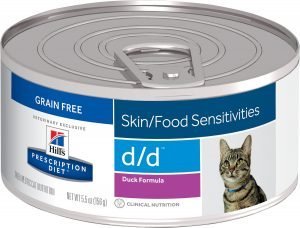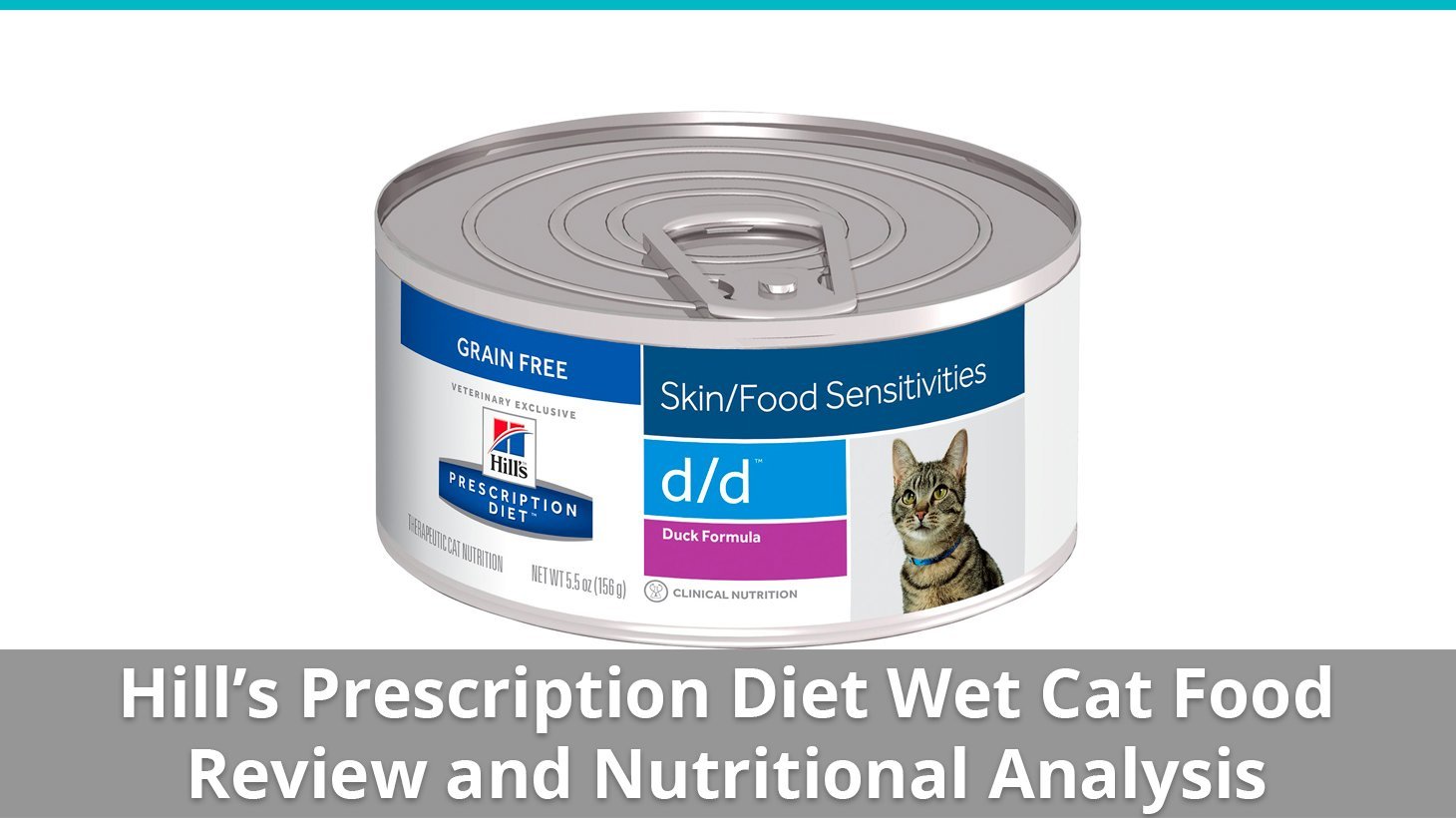Rating
- Meat is the first ingredient – 1 Star
- Uses some unnamed meats – 1 Star
- Above average protein content – 0 Star
- Less than 4 controversial ingredients – 0 Star
- Catological Discretionary Rating – 0 Star
2 things specific to this brand of foods before we get started, which we also covered in our review of the dry food.
- This is a prescription diet, which you can only buy with a prescription from a veterinarian. You can purchase prescription foods from Chewy.com, but will need to provide proof of prescription.
- The Hill’s Prescription Diet includes a huge variety of foods supposedly designed to help with very specific ailments. We will be combining them all into this review, because they are all quite similar, and sadly, they are all very low quality. You’ll learn more below.
Here’s a few important points:
- Meat is the first ingredient
- By-products and filler ingredients are used in abundance
- Protein is typically very low, and carbohydrates are typically very high
- Includes added vitamins and minerals
- While the recipes claim to be good for different ailments, in reality each recipe is low quality and full of biologically inappropriate ingredients
Hill’s Prescription Diet product line includes 28 wet recipes/flavors.
Each recipe below includes its related AAFCO nutrient profile when available on the product’s official webpage or packaging: Growth (G), Maintenance (M), All Life Stages (A), Supplemental (S) or Unspecified (U).
The star rating is a rough average of all of the flavors in a single line of food. If an individual recipe scored lower or higher, we will mark that below, next to the flavor.
- Hill’s Prescription Diet Urinary Care c/d Chicken (M)
- Hill’s Prescription Diet Urinary Care c/d Chicken & Vegetable (M)
- Hill’s Prescription Diet Urinary Care c/d Vegetable, Tuna & Rice (M)
- Hill’s Prescription Diet Urinary Care c/d Ocean Fish (M)
- Hill’s Prescription Diet Urinary Care c/d Stress Chicken & Vegetable (M)
- Hill’s Prescription Diet Urinary Care s/d Chicken (A)
- Hill’s Prescription Diet Kidney Care k/d Chicken & Vegetable (M)
- Hill’s Prescription Diet Kidney Care k/d Vegetable & Tuna (M)
- Hill’s Prescription Diet Kidney Care k/d Pate with Chicken (M)
- Hill’s Prescription Diet Kidney Care k/d Pate with Tuna (M)
- Hill’s Prescription Diet k/d + Mobility Chicken & Vegetable (M)
- Hill’s Prescription Diet Kidney Care k/d Early Support Chicken, Vegetable & Rice (M)
- Hill’s Prescription Diet Digestive Care i/d Chicken (G, M)
- Hill’s Prescription Diet Digestive Care i/d Chicken & Vegetable (G, M)
- Hill’s Prescription Diet Digestive + Weight Management w/d Chicken (M)
- Hill’s Prescription Diet Skin/Food Sensitivities z/d Original (M)
- Hill’s Prescription Diet Skin/Food Sensitivities d/d Duck (M)
- Hill’s Prescription Diet Urgent Care a/d Chicken (S)
- Hill’s Prescription Diet Thyroid Care y/d Chicken (M)
- Hill’s Prescription Diet Glucose/Weight Management m/d Pork (M)
- Hill’s Prescription Diet Metabolic + Urinary Vegetable & Chicken (M)
- Hill’s Prescription Diet Metabolic + Urinary Vegetable & Tuna (M)
- Hill’s Prescription Diet Metabolic Chicken (M)
- Hill’s Prescription Diet Metabolic Vegetable & Chicken (M)
- Hill’s Prescription Diet Metabolic Vegetable & Tuna (M)
- Hill’s Prescription Diet Weight Reduction r/d Chicken (S)
- Hill’s Prescription Diet Aging Care g/d Turkey (M)
- Hill’s Prescription Diet Joint Care j/d Chicken (M)

Hill’s Prescription Diet Skin/Food Sensitivities d/d Duck was selected to represent the other products in the line for this review.
Hill’s Prescription Diet Skin/Food Sensitivies d/d Duck
Wet Cat Food
| Estimated Nutrient Content |
| Protein | Fat | Carbs | |
|---|---|---|---|
| Guaranteed Analysis | 8% | 5.5% | NA |
| Dry Matter Basis | 36% | 25% | 20% |
| Calorie Weighted Basis | 31% | 52% | 17% |
Estimated Dry Matter Nutrient Content
Fiber (guaranteed analysis)
2%
Calories/100g
121
Is real, named meat the first ingredient?
Yes
Ingredients
Water, Duck, Duck Liver, Ground Green Pea, Powdered Cellulose, Soybean Oil, Pea Protein Concentrate, Brewers Dried Yeast, Fish Oil, Glucose, Calcium Carbonate, DL-Methionine, Dicalcium Phosphate, Taurine, L-Cystine, Choline Chloride, Iron Oxide, Glycine, Potassium Chloride, Iodized Salt, Vitamin E Supplement, Potassium Citrate, Thiamine Mononitrate, Ascorbic Acid (source of Vitamin C), Zinc Oxide, Ferrous Sulfate, Thiamine Hydrochloride, Niacin, Pyridoxine Hydrochloride, Beta-Carotene, Manganous Oxide, Calcium Pantothenate, Vitamin B12 Supplement, Riboflavin, Biotin, Vitamin D3 Supplement, Calcium Iodate, Folic Acid, Sodium Selenite.
Ingredients in red are controversial or of questionable quality.
Ingredient Breakdown
After water, the first ingredient in this cat food is duck. Good.
While quality of the individual ingredient can vary, duck is a good protein source for cats.
It’s also important to note that duck contains about 70% water, so when it is processed and cooked for use in cat food, it will become a smaller part of the total recipe.
The second ingredient is duck liver. Good.
Liver is an important organ meat that your cat would eat in the wild to get extra protein, vitamins, and minerals.
This is usually a sign of a high quality food.
The third ingredient is ground green pea. Bad.
Peas are a quality carbohydrate for humans, but cats don’t need much in the way of carbohydrates.
They are full of fiber, but also contain a fair amount of protein, which we should keep in mind when judging the meat content of this food.
Peas are biologically inappropriate for cats, and there doesn’t need to be any in here.
The fourth ingredient is powdered cellulose. Bad.
This is a filler high in insoluble fiber.
It’s typically wood pulp (sawdust) from pine trees.
Too much insoluble fiber can interfere with digestion and inhibit protein and nutrient uptake.
The fifth ingredient is soybean oil. Bad.
Soy is a bad ingredient for cats, particularly soy manufactured in factories in the US, where soy bean protein is used to create other products, compared to Asia, where soy is typically fermented, which makes it much better for the body.
Soy contains many anti-nutrients that inhibits your cat’s body from digesting nutrients from the other foods she eats.
The sixth ingredient is pea protein concentrate. Bad.
This ingredient is a concentrated form of the protein found in peas, which means the actual meat content of this food may be lower than the macronutrient profile suggests. It is a protein booster.
Peas are not the worst carbohydrate your cat can consume, but they’re simply not at all biologically appropriate.
The seventh ingredient is brewer’s dried yeast. Bad.
A by-product of brewing beer, it is used for flavoring and for protein and B-vitamins.
However, some reports suggest that it can become very toxic to the liver, causing allergies and arthritis, in large doses.
This recipe includes a number of other ingredients, but once you get down this far, none of them will be in large enough quantities to make a real difference, except for the added vitamins and minerals.
However, there are still a few things you should know.
Glucose is sugar, and is not appropriate ingredient for felines. It could cause obesity and potentially even diabetes.
Iron oxide is used to color the food and give it a more red, meaty color.
Since it is 100% marketing gimmick, it is unnecessary, and usually the sign of a cheap cat food.
They are likely quite safe, not absorbed into the body, and likely non-toxic, but any coloring additive is questionable, and iron oxide has not been studied as a food additive very thoroughly.
To read a more in depth article about any of the ingredients listed here, check out our Cat Food Ingredient Wiki (currently under development).
The Catological Verdict on Hill’s Prescription Diet Wet Cat Food
From top to bottom, this is a below average wet food.
Meat is the first ingredient, but lower quality by-products are common.
Fillers are used extensively in every recipe, which increases carbohydrate levels. Each filler is also biologically inappropriate for a natural feline diet.
Just because these are prescription-only foods does not mean they are good.
It is worrying that any veterinarian would recommend these, when most of the issues they claim to solve can be solved with a natural diet that comes close to reaching the macro and micronutrient levels that cats would eat in the wild.
Don’t be fooled into thinking that these are high quality, or special in any way. They do not contain special, medicinal ingredients. They are low quality and are likely to do more harm than good to your cat.
Protein is too low and carbohydrates are too high.
This is NOT a good example of a wet food you should be feeding your cat.
Since it’s clear that plant products make up too much of this food, we can assume that this is a mostly plant-based food, which is not ideal for your carnivorous feline’s dietary needs.
To review, on a dry matter basis, this food is 36% protein, 25% fat, and 20% carbs.
As a group, the brand has an average protein content of 37%, and average fat content of 20%, and an average carb content of 30%.
Compared to the other 2000+ foods in our database, this food has:
- Below average protein.
- Average fat.
- Above average carbs.
Because meat is the first ingredient, it is full of fillers, and we don’t believe it’s fair for a company to charge so much for a low quality food, all while calling it prescription, as though it’s special, our rating for this brand is 2 stars.
Not recommended.
Hill’s Cat Food Recall History
We do not believe that a recall indicates a low quality food or company, and we respect the fact that sometimes things happen that cause a manufacturer to recall a food.
Usually these things are non-life-threatening, and we think it’s important to take a moment to be thankful about just how few recalls there really are in the industry, considering the enormous volume of food produced.
However, we do believe that a history of recalls may point to a larger issue with a company, and that discerning consumers want to know who they’re buying from, especially when it comes to something as important as the food you feed your beloved cat.
Here is a list of recalls that have affected the Hill’s brand in the past:
- May 2016 – High iron levels – UK and Russian products affected
- November 2015 (“Withdrawal”, not Recall) – Labeling issues – Multiple dog recipes affected
- June 2014 – Possible salmonella – 1 recipe affected
- April 2007 – Melamine – 1 recipe affected
- March 2007 – Melamine – Multiple cat food recipes affected
If you want to stay up to date on the latest recall information affecting your cat’s food, sign up to our email list and receive an email every time a recall is announced. We’ll also let you know about any updated ratings, recipe changes, or new cat foods on the market. (Our alert system will be launched shortly, check back soon.)
Where To Buy Hill’s Prescription Diet Wet Cat Food
We recommend purchasing your pet products from Chewy.com. They continually prove that they walk the walk while talking the talk, and I’ve never dealt with a more dedicated pet-parent base of people than those who work at Chewy.
Plus, they offer 20% off and free shipping on lots of orders.
Not Convinced?
Check out our ratings and reviews of the best cat foods in our comprehensive, data-backed guide right here.

